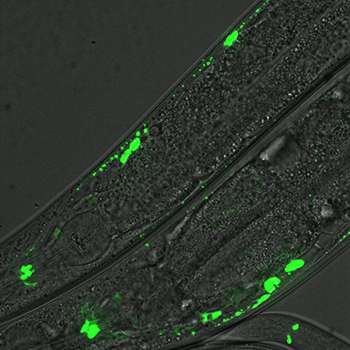In times of energy stress, brain turns to emergency generator

The human brain takes up only 2% of our body weight but uses 20% of the body's energy budget to power the communication between neurons. Stressful conditions put a strain on this energy supply, and disruption of this metabolic state, even briefly, can severely disrupt the brain's cognitive functions.
While studying the in the C. elegans worm, Yale researchers discovered an emergency "energy generator" that assembles quickly where needed to power synaptic function during times of energy stress.
"Energy demands in neurons are constantly changing, and those demands need to be met locally," said Daniel Colón-Ramos, associate professor of cell biology and neuroscience and senior author of research published in the journal Neuron.
Neuronal activity causes changing energy demands at synapses, the points of contact and communication between neurons. These energy demands must be met locally to sustain synaptic function and brain activity. The primary energy sources are microscopic cellular "power plants" called mitochondria, that shuttle around to cater to local energy demands. However sometimes, even mitochondria can't keep up with the capricious changes in energy demands observed in neurons.
That's when glycolytic proteins, ancient enzymes present in all living cells that cooperate in energy production, are mobilized from components throughout the cell to create an emergency generator, the researchers found.
The existence of these generators, called glycolytic metabolons, had been hypothesized for decades but had never been observed in a living organism or in neurons. Unlike the mitochondria, which have all their energy-producing components neatly organized in stable structures, components of the glycolytic metabolon are cytoplasmic, meaning that they are scattered throughout the cell.
"In the nervous system of all animals, information flow in the nervous system comes at a price, and the currency is energy," Colón-Ramos said. "We think of the glycolytic metabolon as a self-assembling energy generator that allow neurons to produce energy locally, when and where it is needed, to power neural function before the lights go out."


















